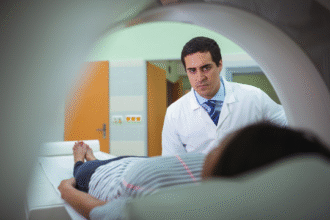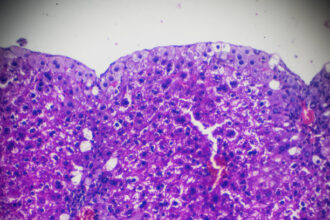Acute Fatty Liver of Pregnancy (AFLP)
Key Points
- AFLP is a rare, life-threatening condition in late pregnancy characterized by microvesicular fatty infiltration of the liver, resulting in acute liver failure.
- Presents between 28 and 40 weeks’ gestation with nonspecific gastrointestinal and systemic symptoms.
- Early recognition and prompt delivery significantly improve maternal and fetal outcomes.
- Management requires a multidisciplinary team, including obstetricians, hepatologists, intensivists, and neonatologists.
Introduction
Acute Fatty Liver of Pregnancy (AFLP) is an obstetric emergency occurring most often in the third trimester. Although the precise etiology remains unclear, defects in fetal fatty acid oxidation (e.g., long-chain 3-hydroxyacyl-CoA dehydrogenase deficiency) and maternal mitochondrial dysfunction are implicated. Without rapid diagnosis and treatment, AFLP can progress to fulminant hepatic failure, coagulopathy, renal failure, and multiorgan dysfunction.
Epidemiology and Risk Factors
- Incidence: 1 in 7,000–15,000 pregnancies.
- Maternal Risk Factors:
- Primiparity (~48% of cases).
- Multiple gestations (14%).
- Maternal age 20–40 years.
- Fetal Influence: Higher risk when fetus has inherited fatty acid oxidation defects.
- Recurrence: Rare, but genetic counseling recommended if fetal metabolic defect identified.
Pathophysiology
- Microvesicular Steatosis: Impaired mitochondrial β-oxidation leads to accumulation of small lipid droplets in hepatocytes.
- Mitochondrial Injury: Accumulated fatty acids generate reactive oxygen species, injuring hepatocytes and precipitating liver failure.
- Multisystem Involvement: Fatty infiltration may affect kidneys, pancreas, brain, and bone marrow, causing renal failure, encephalopathy, and coagulopathy.
Clinical Features
- Prodromal Symptoms:
- Persistent nausea, vomiting (90%+ of patients).
- Abdominal pain (RUQ or epigastric).
- Malaise, anorexia, fatigue.
- Systemic Signs:
- Jaundice, pruritus.
- Hypoglycemia, encephalopathy, coagulopathy (DIC).
- Acute kidney injury (~50% incidence).
- Rapid Progression: Onset to multiorgan failure may occur within days.
Diagnostic Approach
Swansea Criteria (6 of 14 supports AFLP)
- Vomiting
- Abdominal pain
- Polydipsia/polyuria
- Encephalopathy
- Elevated bilirubin (>14 µmol/L)
- Hypoglycemia (<4 mmol/L)
- Elevated uric acid (>340 µmol/L)
- Leukocytosis (>11 × 10⁹/L)
- Ascites or bright liver on ultrasound
- Elevated transaminases (AST/ALT >42 IU/L)
- Elevated ammonia (>47 µmol/L)
- Renal impairment (creatinine >150 µmol/L)
- Coagulopathy (PT >14 s or APTT >34 s)
- Microvesicular steatosis on liver biopsy
Laboratory and Imaging
- Labs: LFTs (AST/ALT), bilirubin, PT/INR, platelets, renal panel, glucose, lactate.
- Ultrasound: Bright, echogenic liver, may show ascites.
- Liver Biopsy: Microvesicular fat but often contraindicated due to coagulopathy.
Differential Diagnosis
- HELLP syndrome (hemolysis, elevated liver enzymes, low platelets).
- Severe preeclampsia.
- Acute viral hepatitis.
- Intrahepatic cholestasis of pregnancy.
- Drug-induced liver injury.
Management
Stabilization and Support
- ICU admission for hemodynamic monitoring.
- Correct hypoglycemia and electrolyte imbalances.
- Manage coagulopathy with FFP, cryoprecipitate, and platelets.
- Provide ventilatory support as needed.
- Initiate renal replacement therapy for acute kidney injury.
Definitive Treatment: Delivery
- Prompt stabilization followed by delivery (often via cesarean for maternal/fetal indications).
- After delivery, maternal condition usually improves rapidly.
Multidisciplinary Care
- Collaboration between obstetrics, critical care, hepatology, and neonatology.
- Genetic counseling for fetal fatty acid oxidation defects.
Nursing Considerations
- Monitor vital signs, intake/output, glucose, and coagulation status frequently.
- Assess neurologic status for encephalopathy progression.
- Administer blood products and glucose infusions as prescribed.
- Provide emotional support and education to patient and family.
- Coordinate early neonatal evaluation for metabolic disorders.
Prognosis and Follow-Up
- Maternal Mortality: <10% with early intervention (historically up to 33%).
- Fetal Mortality: <20% with prompt diagnosis and delivery (historically up to 66%).
- Recovery: Liver function typically normalizes within 1–2 weeks postpartum.
- Recommend follow-up for liver and renal function and genetic evaluation.
Patient Education
- Explain condition, treatment plan, and importance of early delivery.
- Advise on signs of recurrence (rare) and necessity of follow-up.
- Provide resources for psychosocial support and counseling.
References
- Ch’ng CL, Nelson-Piercy C. Recognition and management of liver disease in pregnancy. BMJ. 2019;367:l5406.
- Prince MR, Ehrinpreis MN. Acute fatty liver of pregnancy: a life-threatening disease. Hepatology. 2021;74(2):779-781.
- Royal College of Obstetricians and Gynaecologists. Green-top Guideline No. 40: Acute Fatty Liver of Pregnancy. 2020.
- Nelson DB, et al. Microvesicular steatosis in AFLP. Obstet Gynecol. 2018;132(4):678-685.
- Creanga AA, et al. AFLP in the United States: maternal morbidity and mortality. Obstet Gynecol. 2022;139(3):539-548.







